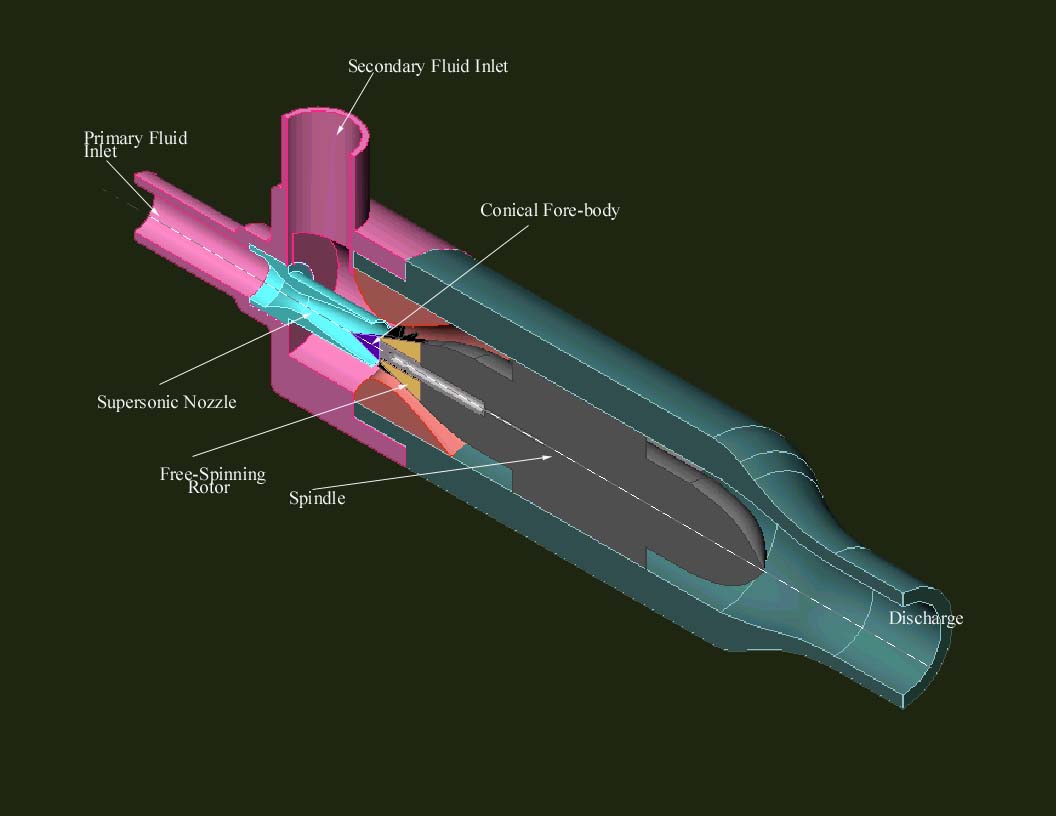
is driven by fluid kinetic or thermal energy as opposed pumps or compressors which are driven by mechanical energy. Applications for such devices are numerous and include power plant air ejectors, steam-jet refrigeration / air conditioners, thrust augmenting
ejectors for propulsion, and a variety of other pumping uses. The advantage of the ejector over mechanical pumping machinery is that it has no moving parts, is simple, can be manufactured at low cost, and can take advantage of high pressure steam, air, water,
or other energetic fluids that may be available in the given application. By means of a boiler, they can take advantage of direct conversion of thermal power to fluid power without the need of intermediate engines or electrical power generation. The primary
disadvantage of these devices is that with conventional ejectors , the energy efficiency is quite low.
The low energy efficiency of a conventional ejector is attributed to the fundamental mechanism by which it operates: turbulent entrainment. Turbulent entrainment, a result of mixing between driven and driving flows, is inherently a dissipative process which results
in the production of entropy. Ideal turbomachinery, which utilizes the work of non-steady pressure forces, can avoid such irreversibilities. However, after a century of research and development on conventional ejectors, we have learned that the performance
level of ideal turbomachinery is unattainable with the with the conventional ejector due to the nature of the physical processes involved.
Recent research, particularly in propulsion applications, has shown that ejectors which utilize non-steady flow can capitalize on the same principles that enable the high performance of turbomachines: the work of non-steady pressure forces - or "pressure
exchange". Since such ejectors utilize reversible pressure-volume work, high energy transfer efficiencies are possible without the entropy production implicit in mixing processes. To date, there has been very little research towards utilizing this proven physical
principle to ejectors for non-propulsion applications.
Our research involves both the experimental and numerical investigation of a recently patented novel pressure-exchange ejector suitable for compressor applications. The basic components of the system include a free-spinning rotor which is mounted on a fixed
spindle on the primary side of the ejector. Built into the rotor are a plurality of canted vanes upon which impinges the supersonic primary flow. Since the nozzles are canted with respect to the radius of the rotor, and the rotor is free spinning. Upon emerging from
the rotor which spins at a very high speed, possibly exceeding 75,000 rpm, the primary jets form a helical pattern and is captured by a radial vaneless diffuser. Between the interstices of the helices from the various primaries, the secondary flow is directed and
trapped. The secondary is thereby pushed into the diffuser by the primary by the work of the interface pressure forces which occur as the primary and the secondary interact at the exit of the rotor. Although the new pressure-exchange ejector involves a single
moving part and is therefore more complicated than a conventional ejector, it remains mechanically simple, being self-driven by the primary fluid.
Several fully instrumented experimental test rigs, each a different configuration, utilizing air as the working fluid have been implemented. The effects of a wide range of parameters on the performance of the pressure-exchange ejector including nozzle exit angles,
nozzle exit Mach No., number of vanes, primary pressure ratios, and diffuser geometry. Furthermore, the performance will be compared with published data on conventional ejectors and the fluid dynamics corresponding to optimal performance will be
discussed. As the proper design of a pressure exchange ejector requires intricate compromises between aerodynamic, mechanical, and structural design, progress is advancing slowly.
To model the characteristics of this novel pressure exchange concept, the commercial fluid flow analysis code TASCflow was acquired. TASCflow uses a finite element based finite volume method to solve the three dimensional Navier-Stokes equations. It uses
multi-block structured grids which can handle complex geometries and is well suited for modeling rotating machinery. It was chosen particularly for its ability to accurately model real gas compressible flows, turbulence, transient effects of time periodic boundary
conditions, multiple and rotating frames of reference, and shocks resulting from transonic and supersonic flow. The solver uses an algebraic multigrid scheme. The computational effort focuses on understanding the unique features of this flow that would be
otherwise be difficult to examine experimentally. The long-range goal of the numerical simulations is aimed at investigating the stability and the mutual interaction between the jets, the structure of shock waves and their effect on the interface pressure distributions ,
and the entropy generation within the flow streams. In the present paper, these flow features are investigated for a simplified geometry.
The pressure-exchange ejector is an exciting concept which could lead to a major breakthrough in ejector performance. Such a breakthrough would enable ejectors to compete with mechanical compressors in a variety of important applications that are not
currently feasible such as in refrigeration, power plants, and many industrial operations. An objective of this coordinated study is to determine the obstacles to the attainment of this level of performance and attempt to overcome them.